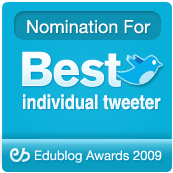Two years ago I got hooked on a project I had assigned myself. A teacher in my building has long led her students in an intensive exploration of the lives of the people living in Appalachia, culminating in student-led tours of all kinds of demonstrations of the depth of their understanding.
I signed up for one of the tours and was absolutely transfixed by the power of the children's imagination. At about the same time, I had been seeing Google- and Slideshare-enabled embedded slide shows popping up in blogs I read. When I read the poems our fourth graders had written in the voices of the people they'd been studying, my immediate thought was for all the people who wouldn't have a chance to marvel at their work, and this is what inspired what happened next.
The students had initially illustrated their poems with drawings, but these had not been converted into a digital format, so I set out to find images that would reflect the strength and deep engagement of the students' language. This in turn led me on a whole exploration of issues of copyright and fair use in the digital age. Once I'd discovered the treasure trove that is the FSA/OWI federal photographic archive, I approached the classroom teacher with my desire to help share the students' work with the wider world, and she helped me think through issues like parent permission and timeline.
Then I hit the internet. I dove into Google Docs and figured out how to generate an embeddable slideshow (not that difficult, as it turned out). I printed out a copy of each of the poems I'd been granted permission to share, and went image hunting. During this process, even though I wasn't able to talk with the students themselves, I felt very much as if I was working collaboratively with them, since their words were providing the starting point for my research. Soon, I was completely taken over by the project. I got up early in the morning, I worked over my lunch hour, I saw images of coal towns in my mind's eye as I was lying in bed at night.
There were some false-starts as I figured out how best to keep track of my research; early on, I found and then lost track of some great images because I hadn't saved the url before moving on. I developed structures and procedures to help encourage more methodical record-keeping, and after a bit I got into a groove. I ask my students every year if they have area of interest or engagement that generates the state that psychologist Mihaly Csikszentmihalyi has termed "flow," a state in in which your whole being is involved and you're using your skills to the utmost. Working on this project was truly a "flow" situation for me.
What made this a powerful learning experience?
- I was working at the edges of my knowledge
- I was inspired by the "raw materials" I had to work with
- There was a collaborative energy contributing to the project
- A strong desire to help shine a light on others' creative work
- A relatively defined window of opportunity (I had my regular work to get back to!)
- I was drawing on both my artistic and technical skills
- I had the feeling that I had identified & was fulfilling an unmet need
(This is the last of three stories
of powerful personal learning that I wrote up
with an eye towards contributing
to Sam Chaltain's Faces of Learning project.
You could, too.)







No comments:
Post a Comment